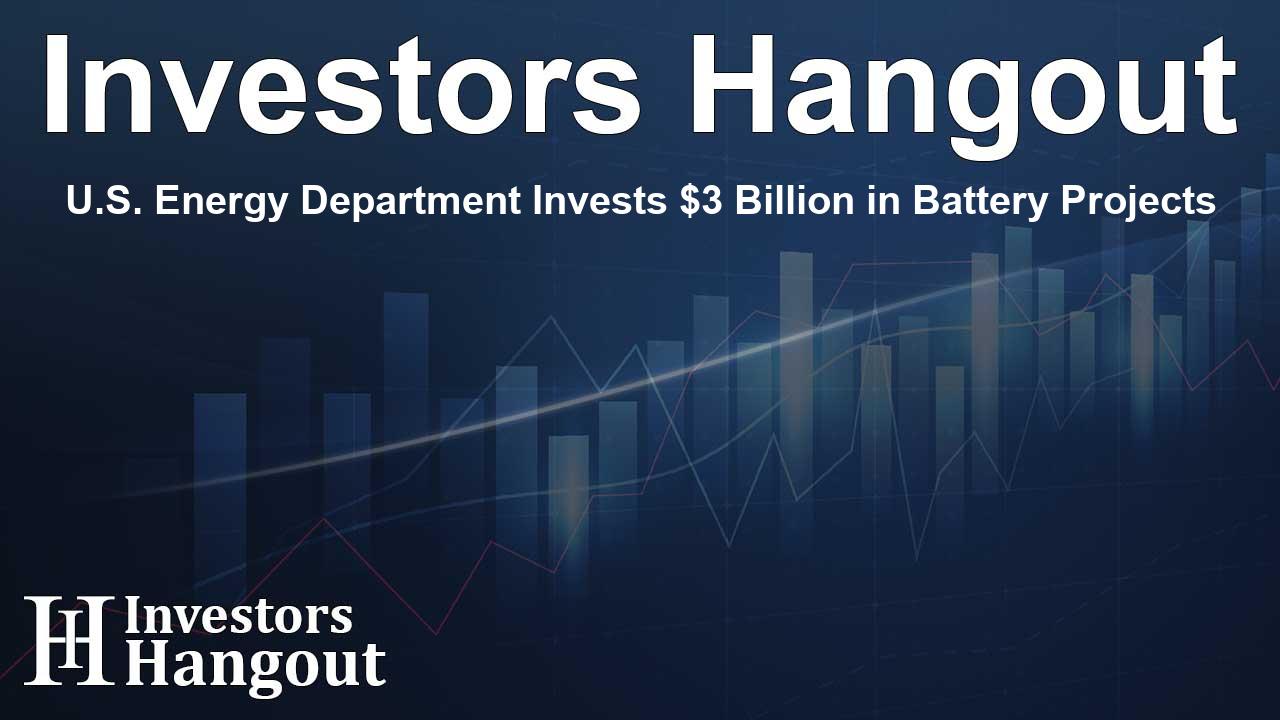U.S. Energy Department Invests $3 Billion in Battery Projects

U.S. Energy Department Allocates $3 Billion for Battery Manufacturing
The U.S. Energy Department has revealed a significant plan involving the distribution of $3 billion across 25 projects in the battery manufacturing sector. This initiative forms part of a broader strategy by the Biden administration to restructure the supply chain for batteries and reduce reliance on imports from China.
Boosting Domestic Production
These projects are set to bolster the domestic manufacture of advanced batteries and critical battery materials. The move aligns with the newly adopted U.S. electric vehicle (EV) tax credit rules, which aim to redirect production processes and critical minerals away from foreign sources, particularly China.
Job Creation and Investment Growth
The funding awarded will specifically support the processing of critical minerals, the manufacturing of battery components, and recycling initiatives. The anticipated outcome is a remarkable total investment of approximately $16 billion, which is expected to create around 12,000 jobs across production and construction.
Insights from Experts
White House climate adviser Ali Zaidi emphasized the importance of mineral security in achieving climate security, stating, "This sets us up to lead on the next generation of battery technologies—from solid state to other new chemistries." This highlights the intention behind this funding initiative, aiming to place the U.S. at the forefront of battery technology innovations.
Key Projects Benefiting from Funding
Among the primary beneficiaries of this funding is Albemarle (NYSE: ALB), which will receive $67 million for a project in North Carolina aimed at the commercial-scale production of anode materials for next-generation lithium-ion batteries. Another notable recipient, Honeywell (NASDAQ: HON), is slated to receive $126.6 million to establish a facility in Louisiana for the production of a crucial electrolyte salt for lithium batteries.
Additional Funding Initiatives
Dow is earmarked for a $100 million award aimed at the production of battery-grade carbonate solvents, crucial for lithium-ion battery electrolytes. Clarios Circular Solutions, in collaboration with SK ON and Cosmo Chemical, stands to gain $150 million for their South Carolina project focused on recycling production scraps from lithium-ion batteries.
Innovations in Lithium Processing
In addition, the department plans to award $225 million for lithium carbonate production by SWA Lithium, a joint venture between Standard Lithium and Equinor. Another project set to receive $225 million is TerraVolta Resources, which focuses on extracting lithium from brine using Direct Lithium Extraction (DLE) technology.
Advancements in Nickel Production
Revex Technologies, backed by Lundin Mining (OTC: LUNMF), will obtain $145 million for the development of three facilities in Michigan. These facilities are designed to process waste from the solely operating primary nickel mine in the U.S., thus providing enough nickel for at least 462,000 EV batteries annually.
Focus on Manganese and Silane Manufacturing
Another recipient, South32 (OTC: SOUHY), will secure $166 million for high purity manganese sulfate monohydrate (HPMSM) mining in Patagonia, Arizona. Currently, a significant portion of HPMSM production occurs in China. Furthermore, Element 25 has been allocated $166.1 million for an HPMSM project in Louisiana derived from manganese ore sourced from its Western Australia mine.
Expanding Silicon Battery Solutions
Group14 Technologies is set to receive $200 million to establish a silane manufacturing plant in Moses Lake, Washington. Silane is a vital ingredient needed in the production of silicon batteries, and securing domestic supply is crucial as most silane currently comes from China.
Future Outlook
Lastly, Birla Carbon plans to utilize $150 million to develop next-generation synthetic graphite without relying on materials sourced from China. Previously, the DOE had awarded $1.82 billion to 14 projects, with selected projects now required to complete negotiations and environmental reviews before formal grants are awarded.
Frequently Asked Questions
What is the purpose of the $3 billion funding announced by the U.S. Energy Department?
The funding aims to support 25 projects in the battery manufacturing sector, boosting domestic production and reducing reliance on foreign sources.
How many jobs will the approved projects create?
The projects are expected to generate approximately 12,000 jobs in production and construction.
Which companies are receiving funding for battery manufacturing?
Key recipients include Albemarle, Honeywell, Dow, and Clarios Circular Solutions among others.
What technologies are being supported by the funding?
The funding supports a variety of innovations, including Direct Lithium Extraction (DLE) technology and the production of advanced battery materials.
Is there an ongoing commitment to sustainability from the Biden administration?
Yes, the initiative demonstrates a strong commitment to sustainability, aiming to secure mineral resources crucial for climate action and enhance domestic manufacturing capabilities.
About Investors Hangout
Investors Hangout is a leading online stock forum for financial discussion and learning, offering a wide range of free tools and resources. It draws in traders of all levels, who exchange market knowledge, investigate trading tactics, and keep an eye on industry developments in real time. Featuring financial articles, stock message boards, quotes, charts, company profiles, and live news updates. Through cooperative learning and a wealth of informational resources, it helps users from novices creating their first portfolios to experts honing their techniques. Join Investors Hangout today: https://investorshangout.com/
Disclaimer: The content of this article is solely for general informational purposes only; it does not represent legal, financial, or investment advice. Investors Hangout does not offer financial advice; the author is not a licensed financial advisor. Consult a qualified advisor before making any financial or investment decisions based on this article. The author's interpretation of publicly available data shapes the opinions presented here; as a result, they should not be taken as advice to purchase, sell, or hold any securities mentioned or any other investments. The author does not guarantee the accuracy, completeness, or timeliness of any material, providing it "as is." Information and market conditions may change; past performance is not indicative of future outcomes. If any of the material offered here is inaccurate, please contact us for corrections.